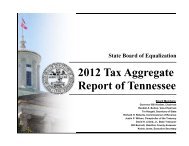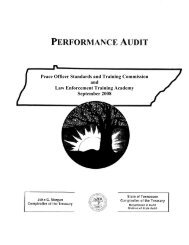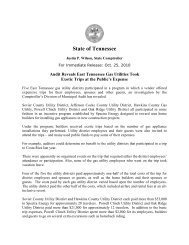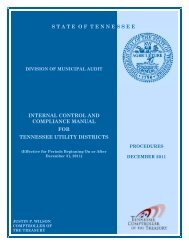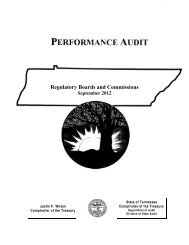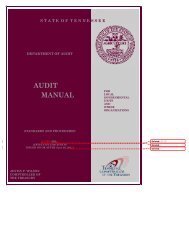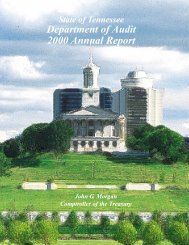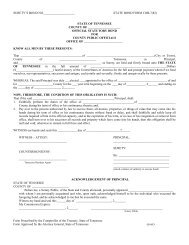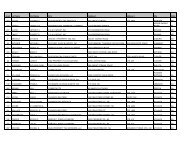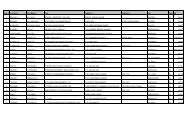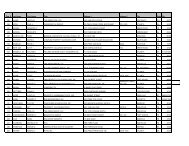On 06/30/2013 the Audit Manual was updated. For a markup copy ...
On 06/30/2013 the Audit Manual was updated. For a markup copy ...
On 06/30/2013 the Audit Manual was updated. For a markup copy ...
Create successful ePaper yourself
Turn your PDF publications into a flip-book with our unique Google optimized e-Paper software.
Reporting and <strong>Audit</strong>ing Requirements – Tennessee Municipalities Section C<br />
2. Additionally, an opinion on whe<strong>the</strong>r <strong>the</strong> accompanying information is<br />
fairly stated in all material respects in relation to <strong>the</strong> basic financial<br />
statements taken as a whole is preferred for ALL supplementary<br />
information. However, at a minimum <strong>the</strong> combining, individual fund,<br />
and budgetary schedules as well as <strong>the</strong> utility detail required by items<br />
4.f.(3), (4) and (5) below and <strong>the</strong> Schedule of Expenditures of Federal<br />
Awards and State Financial Assistance must be opined on in relation to<br />
<strong>the</strong> basic financial statements.<br />
3. Additional Detail Required for Revenues and Expenditures:<br />
In addition to revenues being presented by source (e.g., taxes,<br />
intergovernmental revenues, licenses and permits, and fines, and forfeits,<br />
etc.) as required by generally accepted accounting principles, taxes and<br />
intergovernmental revenues should be fur<strong>the</strong>r detailed by specific source<br />
(e.g., property tax, TVA-in lieu of tax, beer tax, gasoline and motor fuel<br />
tax, etc.).<br />
In addition to being classified by function (or program) and character<br />
(e.g., current, capital outlay, debt service and intergovernmental<br />
expenditures) as required by generally accepted accounting principles,<br />
expenditures should be fur<strong>the</strong>r detailed by object classes. .<br />
The additional detail of revenues by specific source and expenditures by<br />
object classes should be ei<strong>the</strong>r in <strong>the</strong> financial and/or budgetary<br />
statements or schedules of <strong>the</strong> major and nonmajor funds or, asin<br />
additional supplemental schedules. Excessively detailed object<br />
classifications for expenditures should be avoided.<br />
4. Supplemental Information:<br />
(Please refer to <strong>the</strong> Codification of Governmental Accounting and<br />
Financial Reporting Standards, Section 2200.184208 - 209, for<br />
additional details on all combining statements.)<br />
a. Combining statements for nonmajor governmental and<br />
proprietary funds.<br />
b. Combining statements for internal service funds.<br />
c. Combining statements for fiduciary funds (trust funds and<br />
agency funds). Please note that for agency funds, a combining<br />
statement of changes in assets and liabilities is required.<br />
d. Individual budgetary schedules for all governmental funds with<br />
annual appropriated budgets that were not included as basic<br />
financial statements. (The schedule should include three (3)<br />
columns, one for <strong>the</strong> original budgetary amounts, one for <strong>the</strong><br />
C-3



